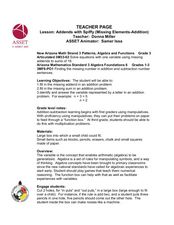Curated OER
Monster Frog Function Machine
Elementary schoolers use a function machine in order to help them look at the relationship between input and output, and to look at the rule for the change. The machine is actually a cardboard box, and it serves quite well for the lesson...
NOAA
Biological Oceanographic Investigations – Call to Arms
How many simple machines does it take to make a robotic arm? An inquiry-based instructional activity explores that topic and challenges pupils to build a robotic arm that can stretch, turn, and more. A few questions help guide...
Curated OER
Gadget Anatomy
Sure to be a hit with your charges, here is a science lesson that has lots of hands-on activities packed into it. The focus is simple machines, and how they help us perform work. After a discussion and demonstration session, groups of...
Curated OER
The Function Box
Pupils explore arithmetic and numerical patterns. After observing a teacher created function box, students describe a pattern and predict what will "come out" of the function box. They explore patterns such as geometric shapes,...
Curated OER
The Function Box
Students look around classroom and identify any patterns they see, describe patterns and explain why they are patterns, use pencil to demonstrate arithmetic patterns by tapping, practice predicting patterns by using Function Box, and...
Curated OER
All Steamed Up
Pupils examine the energy conversions and simple machines are involved in the operation of a steam engine. They make a replica of a small steam engine.
Curated OER
Gadget Anatomy
Fifth graders examine and identify different simple machines that make up complex machines. They analyze and discuss different gadgets and appliances brought in from home, then in small groups examine one of the machines in detail. ...
Curated OER
Patterns, Relations, and Functions: Lesson 3: Numerical Patterns
Fourth graders extend and continue numerical patterns using function or input/output machines. They finish the increasing patterns using input/output tables, and generalize the rules that apply to the pattern. They complete the...
Curated OER
Addends with Spiffy
Young scholars solve single variable equations. In this missing addend lesson, students solve problems with missing addends. Young scholars create a function box to help study numerical reasoning.
Curated OER
Friction and Machines
Fifth graders experimentally determine the relationship of friction to the functioning of machines. They demonstrate that rollers can decrease frictional force and increase speed and research to discover other ways that friction can be...
Curated OER
Generating and Recording Data
Students demonstrate their ability to collect, organize, and display data. They examine everyday objects that can be turned into a function machine for the lesson. They use colored fish to help them organize their data.
Curated OER
Lungs: The Breathing Machine
Students create a model of the lungs and diaphragm. In this breathing lesson, students create a model out of a plastic bottle and balloons. They see how the diaphragm helps to fill the lungs with air.
Curated OER
Our Inventions
Learners construct or draw an invention of their own design. In this problem solving lesson plan, students define the word invention, discuss famous inventions, invetors, and how inventions come about. Learners work in groups...
Curated OER
Tool Shop
Students learn how tools help us accomplish things. In this tool discovery lesson, students review the function of tools. They then make a class chart and categorize different types of tools found in the classroom. Finally, they create a...
Curated OER
Same As
Explore the concept of the equals symbol. In this mathematical symbols activity, learners discover the meaning of the equals sign (symbol). They also construct addition and subtraction sentences to understand the concept of equal parts.
Curated OER
Circle of Life
Here is a well-designed science instructional activity that shows learners that everything that organisms do in ecosystems, including running, breathing, burrowing, growing, requires energy. After a thorough discussion of their own...
Curated OER
The Case of Regulation in Cells
After your biologists have learned about transcription, translation, and gene regulation, they work in a small group to create a poster of a system that serves as an analogy of the gene regulation process. They share their creations with...
Curated OER
Parts of a Cell Analogy
Students reinforce comprehension of the parts of a cell. Theyl synthesize this content knowledge in a descriptive paragraph writing assignment.
Curated OER
Circle of Life
Students consider why we eat and where our food obtains its energy. They illustrate food chains that might be found on an open field, dissect owl pellets, identify the remains of animals in the pellets, watch videos and participate in...
Curated OER
A Coloring Book From My Friends
First graders create a coloring book based on pictures they pick out. They use Microsoft Paint to create their illustrations. They write sentences at the bottom of each picture.



















